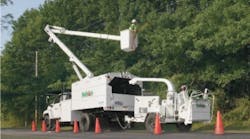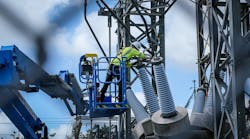Sumter Electric Cooperative Inc. is skillfully managing what was once a tricky balancing act. The Florida electric cooperative is deeply committed to keeping the lights on, costs down and area vegetation healthy for its 175,785 members — and it has the satisfaction rankings to prove it. Sumter Electric Cooperative (SECO) scored an 85 in the American Customer Satisfaction Index, eclipsing the national scores of other electric utilities, communications companies and manufacturers.
SECO's service territory lies directly in the middle of what many consider to be the lightning capital of the world. With 4,620 miles (7,435 km) of overhead lines serving seven Florida counties, a top-notch vegetation management program is critical for SECO to keep its commitments. For this coop, preparedness has proven to be everything, as severe thunderstorms are a way of life in the Sunshine State. In 2004, three hurricanes directly impacted SECO's coverage area, resulting in huge restoration efforts due to numerous downed trees. As a result, SECO has had its share of managing storm damage and has come to regard the work as regularly scheduled fire drills.
Costs Going Up, Reliability Going Down
Prior to 2004 and its run of wild weather, SECO was paying vegetation management line clearance contractors on a lump-sum basis to conduct line clearing on a three-year cycle. Despite ongoing efforts to keep rights-of-way cleared, system reliability continued to decline while costs steadily increased. This, in part, was because SECO deferred to its customers regarding tree removal in an effort to keep member satisfaction high.
With damage from the 2004 hurricanes as a catalyst, SECO became determined to boost overall system reliability, reduce costs and better manage the safety of its distribution area. To achieve that, in 2005, SECO enlisted ACRT, an independent utility vegetation management firm with a broad national footprint, to conduct a detailed system assessment of the utility's entire program. The ultimate goal was to develop an effective integrated vegetation management plan that could support SECO and its members through all the inclement weather Florida could muster.
The assessment evaluated current pruning practices, plan specifications and the overall impact of the vegetation management plan. ACRT planners performed the assessment using a statistically valid random sample of SECO's lines. Using the data collected from these samples, along with other elements of the assessment, several important findings were revealed:
-
SECO's current clearing distances did not allow for three years of regrowth. This caused tree limbs to contact energized facilities before the cycle was over, creating outages.
-
Statistical modeling found tree limbs were in contact with 2% of SECO's live facilities.
-
Although SECO's practices were acceptable, they could be improved.
Putting the Plan in Motion
In April 2006, following ACRT's recommendations, SECO began implementing a new integrated vegetation management action plan. The coop deployed a new set of trimming specifications, launched an aggressive easement reclamation program and modified its contracting method from lump-sum to per-unit pricing for all cycle-based pruning. This modification allowed for significant cost reductions, because it shifted responsibility for maintaining production levels away from SECO and back to the contractor group conducting the line clearance maintenance.
With unit-based pricing, line clearance contractors are only compensated for work performed. In simple terms, SECO pays set pricing for the type of work executed such as side trims, overhang trims and 4-inch to 10-inch (102-mm to 254-mm) removals. All emergency project work and reactive pruning would be handled by separate hourly crews.
The new pay structure also boosted customer satisfaction. With the per-unit plan, SECO was no longer paying line clearance contractors for time or distance but for results only. If SECO members noticed line clearance contractors taking a break, SECO and its members no longer had to worry about being charged for unproductive time.
From Zero to 40,000
Under the new direction, ACRT planners worked with SECO to manage pruning cycles, provide member notification, obtain access for the line clearance crews and prescribe the correct pruning method — with a laser focus on selecting trees for removal within the scope of the program's objectives. In the first year of the new plan, SECO removed more than 40,000 established trees from its rights-of-way. This figure represented more than 30% of all units. Prior to implementation of the new plan, the number of trees removed had been zero.
What is more, because of this aggressive plan, SECO had the ability to begin running a flat budget for the next three years. With the reduction in unit count, the cost per mile had been reduced significantly, falling from as high as 140 units per mile prior in 2004 to currently 65 units per mile in 2012. SECO now can plan more miles with the same or even less expense, which makes the new vegetation management program a solid return on investment. This allows SECO to maintain its program objectives despite the rising costs of fuel and other related expenses.
For SECO, effective vegetation management is more than just cutting holes in the sky, but those holes are critical to managing the safety and reliability of the entire system. Becoming more proactive in tree removal has moved the coop steadily toward long-term cost reduction and enhanced reliability.
Cycling to Success
Now in year two of its second three-year cycle under the new plan, SECO continues to remove an average of 30,000 trees per year and continues to maintain high levels of member satisfaction. The coop attributes this, in part, to its members gaining one-on-one interaction with professional utility arborists in the field. Every planner or manager who represents SECO in the field is a certified arborist who can talk with members about their concerns and educate them about proper pruning to ensure the safety and reliability of the lines. Because a majority of tree removals are voluntary, it is critical for the arborists in the field not only to be knowledgeable about SECO's vegetation management program, but also to understand the impact it has on its members and their perspective.
To help members become more engaged, trained ACRT arborists clearly articulate the importance of tree removal and the trees' potential impact on electric reliability. They explain that removing trees in the path of energized lines provides better aesthetics for the area as well as healthy tree growth beyond the power lines. To further quell member concerns, SECO operates with a tree replacement program. Its members are able to speak directly with arborists about having a problem tree replaced with a compatible power-line-friendly tree to ensure the utility is not removing one problem and replacing it with a future problem.
Compared with other vegetation management programs, SECO's program is slightly unusual by having subject-matter experts in the field speaking to members, but using ACRT's certified arborists has made a huge impact in getting members involved in the process and obtaining permission to remove trees. This practice has helped SECO to develop a strong professional workforce while making a positive statement about the program to the public and the rest of the industry.
Technology Never Sleeps
Boosting the use of technology in the field also has brought far-reaching benefits for SECO. Planners now use tablets for data collection, mapping and inventorying the system using vegetation management software. Collecting this concise data not only helps with planning, it also provides cost savings in terms of equipment and personnel needs. When outage data is tied in with the geographic information system software, SECO has accurate records to help predict the workload for pruning cycles and identify for drivers where and when to prune. Its annual plan and order of cut are determined by reliability and numbers of consumers. In this way, system reliability and performance can be compared to the previous cycle's performance.
As technology evolves, so should the direction of a successful vegetation management program. At SECO, program evolution and the use technology have yielded positive results.
Another vital component that helps to make SECO's current plan so successful is its fortitude and commitment to stick with it. With input from ACRT and a valued team of line clearance contractors, SECO executes a comprehensive, integrated vegetation management program. The program includes planning, pruning, post-auditing and an aggressive tree removal process. In addition, SECO uses a fully integrated systemwide herbicide program that also goes through a post-application auditing process.
Persistence with a plan is vital. For many utilities, the inability to continue moving forward on a common process, and instead trying something new every year, can end up costing more over time, not only in dollars and reliability, but in customer satisfaction, as well.
Wild Weather, Hazardous Trees
With such unpredictable weather in Florida, SECO remains ever alert and is fully prepared when a weather event is predicted. In Florida, this can include more than hurricanes and tropical storms; tornadoes, hail, flash floods, storm surges and lightning routinely wreak havoc on SECO's coverage area.
Within its process, SECO begins storm preparation long before inclement weather hits the radar by effectively addressing hazard trees on a routine basis. Its hazard tree process identifies trim-related and non-trim outages (outages caused by trees within the easement zone versus outages caused by trees outside of the easement zone). When SECO first started tracking these units, the utility discovered trees outside of the specified trim zone were causing more outages than those within because of unavoidable factors, including poor pruning practices, edge trees and developmental intrusion.
Using trained personnel as part of SECO's time and material workforce, hazard trees are now proactively identified or captured during routine work planning and are then scheduled for removal within 30 calendar days of being issued. This process has decreased tree-related outages extensively. Eliminating dead, dying, decayed and deformed trees has greatly reduced the problems SECO faced in 2004.
For major weather events, when the first warnings go out, the utility proactively gathers equipment and notifies its on-site crews. SECO handles all logistics ahead of time, including food provisions and staging locations for crews. ACRT planners also participate in storm restoration, assisting SECO and the tree crews in preparation for the response and coordinating locations where tree work is necessary for restoration of power. There are no downtimes or rally groups; SECO is always fully staffed, bringing experience and knowledge to each event and promoting a more uniform and efficient production.
The storm crews set up in pre-established command centers and SECO possesses the ability to use algorithms to help predict the extent of damage across the system post-storm. Although there has not been a direct impact from a hurricane since 2004, SECO's preparation has paid off in lesser storms and wind events, resulting in fewer outages with shorter durations.
Always poised to handle wild weather, SECO also clears 100% of brush and low-growing vegetation as part of its herbicide program. This helps to clear the way for line and tree crews to access power lines and locations during outages. Trees and other vegetation near switching and fusing points that might hinder access during the restoration process also are removed. These efforts have contributed much in the way of quicker restoration times to its members.
Working Toward World Class
SECO's vision is to be the definition of word-class vegetation management. SECO has been an accredited Tree Line USA utility organization for five years consecutively, and its program leadership is active in the Florida Urban Forestry Council. With such outstanding numbers and proven methodology, SECO representatives attend conferences regularly and liberally share the coop's experiences.
Because SECO has made vegetation management a 365-day operation grounded in preparedness and driven by commitment, the utility has positive, well-documented results regarding safety, reliability and outage control. This makes an effective and strengthening vegetation management program an easy sell to members and board members alike.
Having and placing trust in partners and contractors also is an important component of a great program, and SECO credits its contractors, including ACRT, for the coop's success. ACRT continues to work with SECO on the latest innovations in vegetation management. To contribute to SECO's vegetation management program, everyone is committed to the buy-in of world-class integrated vegetation management.
Ken Lacasse ([email protected]) has been with Sumter Electric Cooperative Inc. for 26 years and currently serves as manager of integrated vegetation management. He is responsible for managing SECO's integrated vegetation management program, reducing outages across its service territory, maintaining an effective three-year trimming schedule and ensuring compliance with the Florida Public Service commission mandates for storm hardening. Lacasse is a certified utility arborist and is active in the industry as vice president of the Florida Urban Forestry Council.
Companies mentioned:
ACRT | www.acrtinc.com
ACSI | www.theasci.org
Florida Urban Forestry Council www.fufc.org
Sumter Electric Cooperative Inc. www.secoenergy.com
Tree Line USA | www.arborday.org







